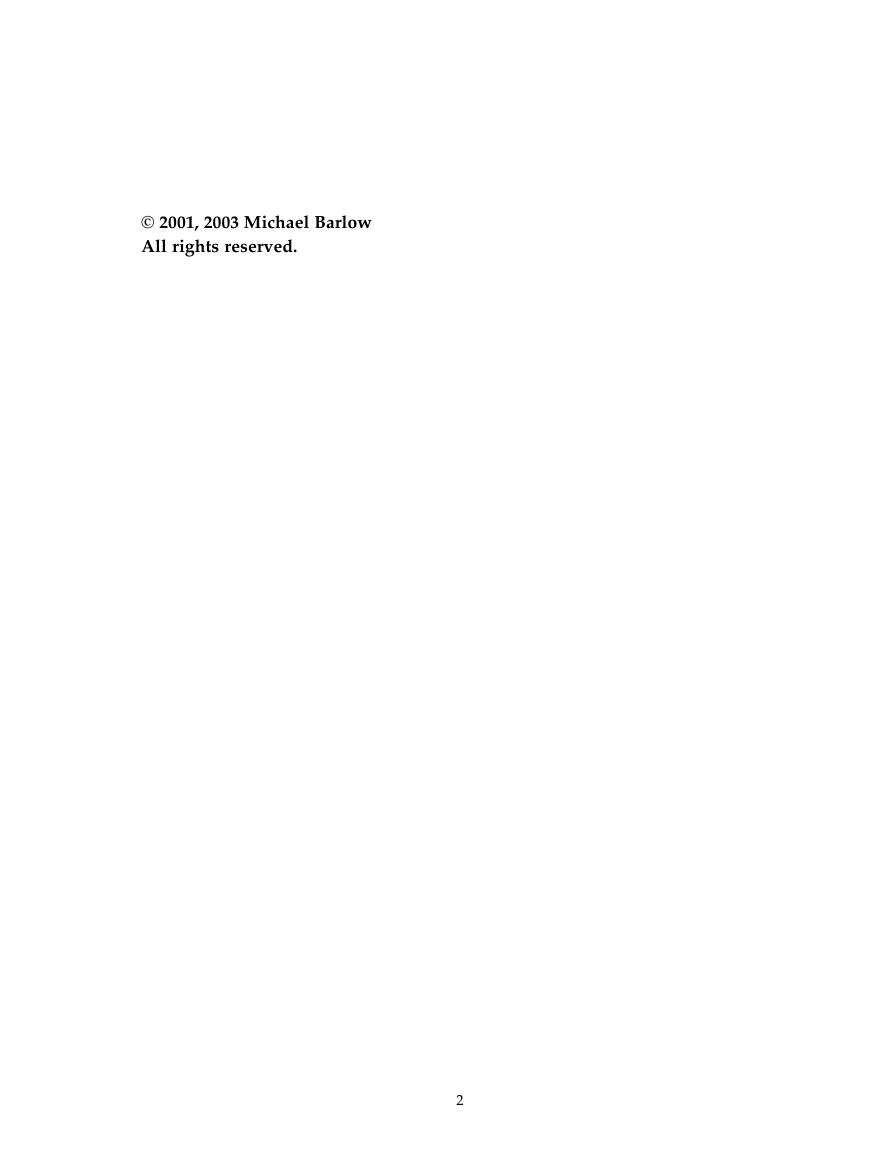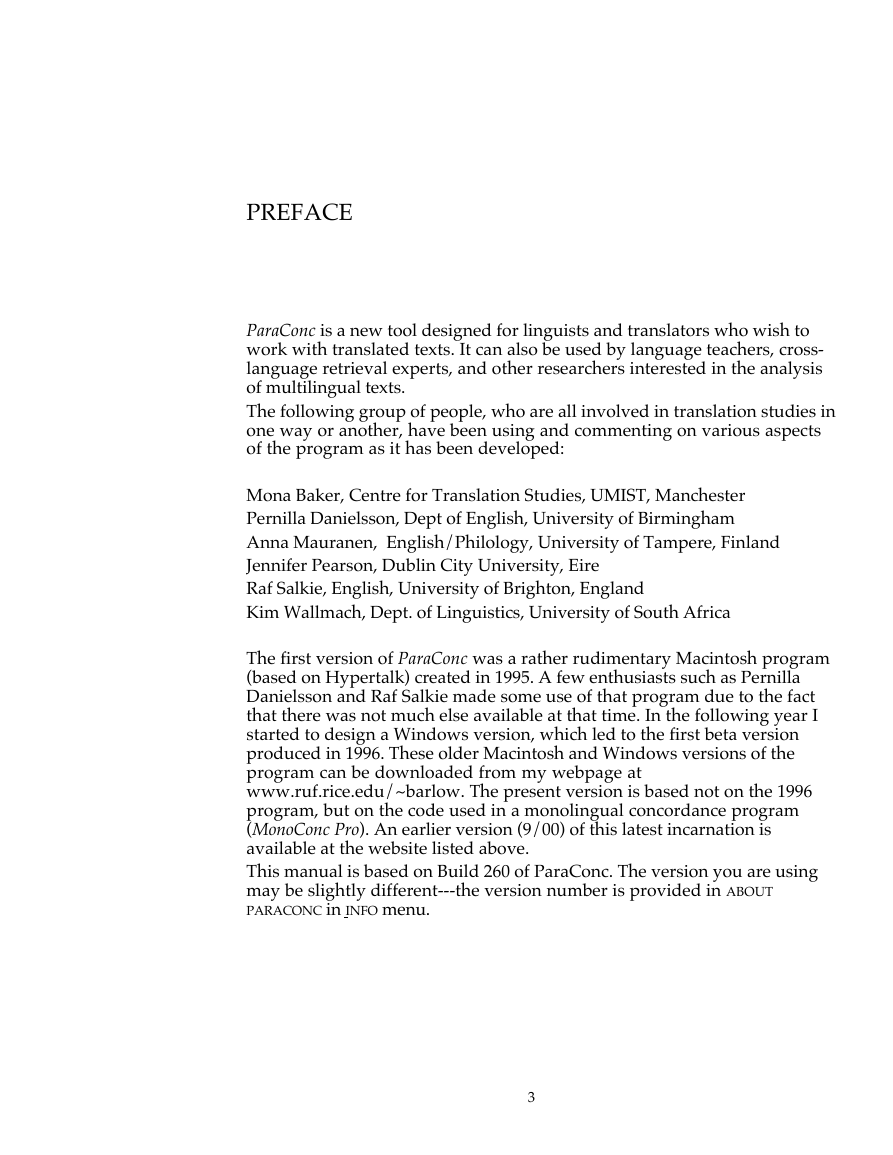ParaConc:
A Concordancer for Parallel
Texts
( D ra f t 3 / 0 3)
Michael Barlow
�
© 2001, 2003 Michael Barlow
All rights reserved.
2
�
PREFACE
ParaConc is a new tool designed for linguists and translators who wish to
work with translated texts. It can also be used by language teachers, cross-
language retrieval experts, and other researchers interested in the analysis
of multilingual texts.
The following group of people, who are all involved in translation studies in
one way or another, have been using and commenting on various aspects
of the program as it has been developed:
Mona Baker, Centre for Translation Studies, UMIST, Manchester
Pernilla Danielsson, Dept of English, University of Birmingham
Anna Mauranen, English/Philology, University of Tampere, Finland
Jennifer Pearson, Dublin City University, Eire
Raf Salkie, English, University of Brighton, England
Kim Wallmach, Dept. of Linguistics, University of South Africa
The first version of ParaConc was a rather rudimentary Macintosh program
(based on Hypertalk) created in 1995. A few enthusiasts such as Pernilla
Danielsson and Raf Salkie made some use of that program due to the fact
that there was not much else available at that time. In the following year I
started to design a Windows version, which led to the first beta version
produced in 1996. These older Macintosh and Windows versions of the
program can be downloaded from my webpage at
www.ruf.rice.edu/~barlow. The present version is based not on the 1996
program, but on the code used in a monolingual concordance program
(MonoConc Pro). An earlier version (9/00) of this latest incarnation is
available at the website listed above.
This manual is based on Build 260 of ParaConc. The version you are using
may be slightly different---the version number is provided in ABOUT
PARACONC in INFO menu.
3
�
4
�
CONTENTS
1. Introduction
2. Installation
2.1 Requirements
3. Aligning files
4. Starting ParaConc
4.1 Selecting a corpus
4.2 Choosing a language
4.3 Adding files
4.4 Aligning the corpora
4.5 Loading the corpus
4.6 Displaying the corpus files
4.7 Changing the corpus
9
11
11
2.1.1 Disk space
11
2.1.2 Compatible versions of Windows 11
11
2.1.3 RAM
13
15
17
18
19
20
24
25
26
27
30
31
32
33
35
37
38
38
39
40
41
41
42
38
5.5.1 Paradigm option
5.6 Context window
5.7 Using wildcards
5.8 Saving the concordance lines
5.9 Printing the concordance results
5.1 Results in two languages
5.2 Sorting the results
5.3 Suggesting translations
5.4 KWIC results II
5.5 Hot words
6.1 Frequency options
6.2 Stop list
6.3 Saving and printing the frequency results
5. Performing a basic concordance search
6. Corpus frequency information
5
�
7 Collocates and Collocations
7.1 Collocate frequencies
7.2 Highlighting collocations
7.3 Advanced collocations
7.3 Saving and printing
8. Working with a corpus
8.1 Tag settings
8.2 Tags
8.3 Part of Speech tags
8.4 Meta-tags
8.5 Using workspaces
8.6 Saving a workspace
8.7 Opening a workspace
9. Performing an advanced or parallel
concordance search
9.1 Text search
9.2 Regular expression search
9.3 Tag search
9.3.1 Searching for words and tags
9.3.2 Searching POS tags
9.3.3 Searching for words
9.3.4 Meta-tags
9.3.1 Searching for punctuation
9.4 Parallel search
10. Performing additional kinds of searches
10.1 Context search I
10.2 Context search II
10.3 Heading search
10.4 Append search
11. General search control and search options
11.1 Ignore case of characters
11.2 Skipping and equal characters
11.3 Sentence mode
11.4 Maximum number of hits
11.5 Frequency of hits
11.6 Changing context type and size
11.7 What is a word?
6
45
45
46
47
48
49
49
52
54
54
55
55
56
57
59
59
63
64
65
65
65
66
66
69
69
69
71
72
73
73
74
74
74
74
75
75
�
11.8 Changing the wildcard characters
11.9 Headings
12. Displaying the results
12.1 Navigation
12.2 Change font and highlight font
12.3 Word wrap
12.4 Suppress words/tags
12.5 Distribution
12.6 Locating hits
12.7 Changing the display: KWIC, Sentence,
13. The power of sorting
13.1 Sorting
13.2 Advanced sort
13.3 User-defined sort
13.4 Sorting tracked tags
15. Exiting the program
Index
76
77
79
79
79
79
79
79
81
81
83
83
83
84
85
87
89
7
�
8
�
















 2023年江西萍乡中考道德与法治真题及答案.doc
2023年江西萍乡中考道德与法治真题及答案.doc 2012年重庆南川中考生物真题及答案.doc
2012年重庆南川中考生物真题及答案.doc 2013年江西师范大学地理学综合及文艺理论基础考研真题.doc
2013年江西师范大学地理学综合及文艺理论基础考研真题.doc 2020年四川甘孜小升初语文真题及答案I卷.doc
2020年四川甘孜小升初语文真题及答案I卷.doc 2020年注册岩土工程师专业基础考试真题及答案.doc
2020年注册岩土工程师专业基础考试真题及答案.doc 2023-2024学年福建省厦门市九年级上学期数学月考试题及答案.doc
2023-2024学年福建省厦门市九年级上学期数学月考试题及答案.doc 2021-2022学年辽宁省沈阳市大东区九年级上学期语文期末试题及答案.doc
2021-2022学年辽宁省沈阳市大东区九年级上学期语文期末试题及答案.doc 2022-2023学年北京东城区初三第一学期物理期末试卷及答案.doc
2022-2023学年北京东城区初三第一学期物理期末试卷及答案.doc 2018上半年江西教师资格初中地理学科知识与教学能力真题及答案.doc
2018上半年江西教师资格初中地理学科知识与教学能力真题及答案.doc 2012年河北国家公务员申论考试真题及答案-省级.doc
2012年河北国家公务员申论考试真题及答案-省级.doc 2020-2021学年江苏省扬州市江都区邵樊片九年级上学期数学第一次质量检测试题及答案.doc
2020-2021学年江苏省扬州市江都区邵樊片九年级上学期数学第一次质量检测试题及答案.doc 2022下半年黑龙江教师资格证中学综合素质真题及答案.doc
2022下半年黑龙江教师资格证中学综合素质真题及答案.doc